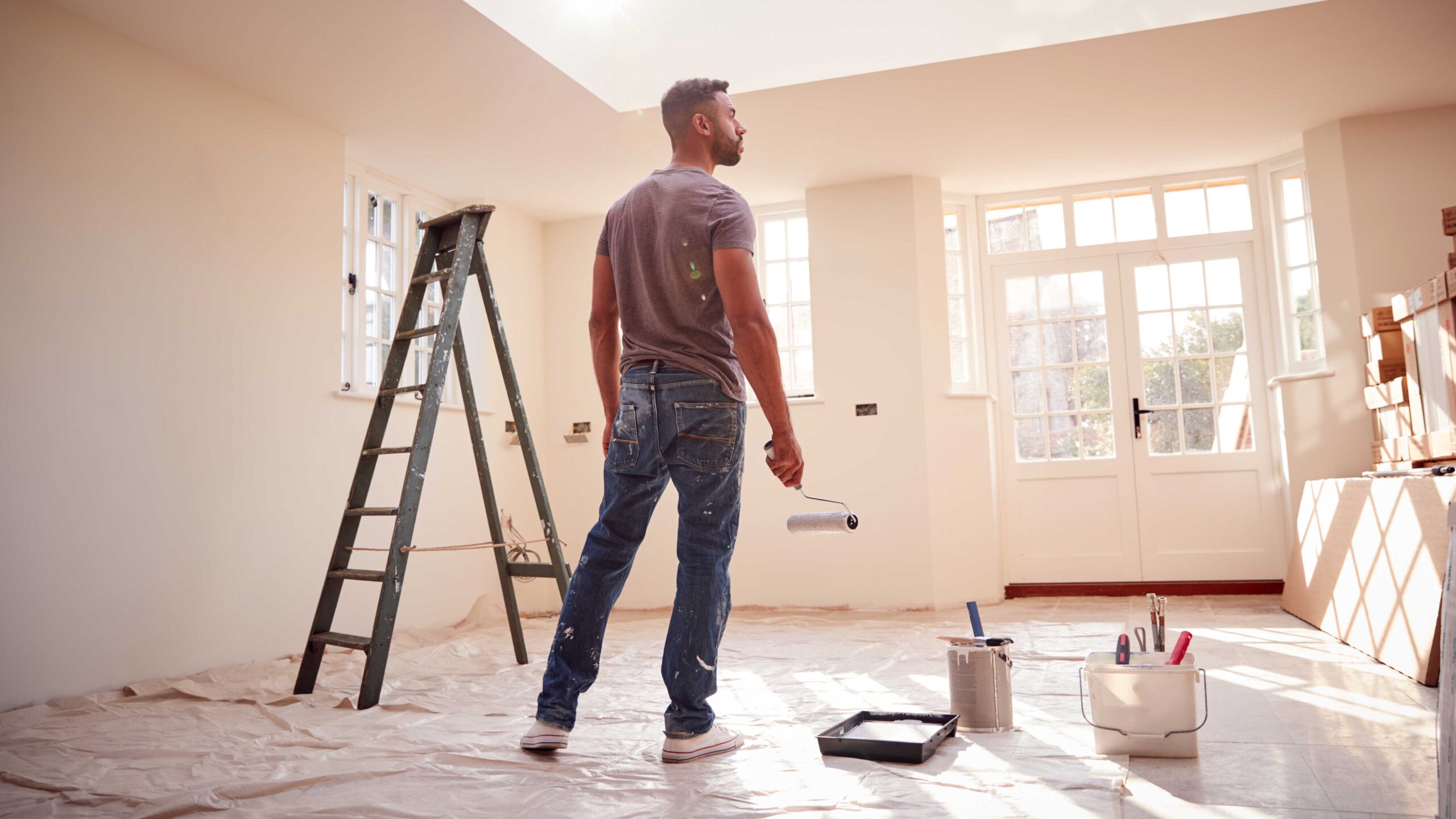How to Prep Walls for Painting
Painting walls is a rewarding and fun experience, mainly when you can marvel at your accomplishments. A bad painting job can frustrate you, especially when the results are not due to your ability. Preparation is key when painting any surface or material, no matter what. Here’s a step-by-step guide on adequately preparing your walls before painting.
Step By Step Method To Prep Your Walls Before Painting
If you want to ensure that your painting project is a great success, the first step is to prepare the room. This mainly includes cleaning, priming, and sanding. Check out our guide below to help you understand better:
Step 1: Clean the walls before painting
To prepare a room for paint, the walls must be clean. There is no perfect way to clean a wall before painting. However, you can wash most walls with a sponge and warm water. If you have a surface exposed to oil, grime or grease, such as kitchen walls, use a mixture of water and a detergent designed to cut through grease. Then, rinse with water to remove the residue. Then, wipe the walls down with a damp towel.
It is essential to let the paint and primer dry completely. If you apply primer or paint on damp walls, it can lead to several problems like Blistering.
Step 2: Removing Mildew
If you plan to paint a room, you should always prepare it properly. Take action against mildew first. Paint over mildew is a bad idea. It will spread through the new paint, making cleaning and maintenance more difficult.
A sponge and a solution of three to four parts water and one part bleach will clean mildew. After applying the solution and letting it set for several minutes:
- Use a soft-bristled brush to scrub the surface.
- Rinse the area thoroughly with clean water.
- Wear gloves and goggles, and give the area time to dry.
Step 3 : Don’t forget the painter’s tape
Painter’s Tape is the best option if you are not a professional cutting into walls. Tape off trim, mouldings, floors, and other surfaces you do not want to paint. You can paint faster if you don’t worry about painting the perfect line.
Remove the tape as soon as the paint has a slightly tacky feel. You can avoid having to rip off the dried paint.

Step 4: Sand surfaces before painting
Sanding rough walls is not necessary for all paint projects, but it’s important to sand them before painting to ensure the paint flows smoothly. Sand any uneven surfaces with sandpaper, a sanding board or a damp cloth. Let the paint dry completely.
It is important to smooth walls painted in gloss or high gloss before painting. Sand previously painted the water-based painting with fine-grit paper. Use a medium-grit (100-150-grit) sandpaper for oil-based paint. Wipe off any remaining debris, and let the paint dry.
Paint flaking or cracking on previously painted surfaces is also a problem. Cracking paint on walls and ceilings can be caused by several factors, but poor surface preparation before painting is the most common. It is not a good idea to paint over cracked paint. Instead, remove all flakes by sanding and scraping the surface.

Step 5: Prime Your Walls
A primer allows for an even and smooth application of the paint colour. This will help you get the best out of your paint, especially if surface stains or your walls have a porous finish.
Consider using a primer if you’ve had any water damage or other similar problems.
Use a primer only to conceal mold, mildew and unaddressed water problems. Investigate the source of the issue and then treat it accordingly. The primer will help to hide the remaining stain.
Let the primer dry for at least two hours before you begin painting. Apply the second coat and let it dry for two hours again before painting.
You can open your paint cans once the walls are dry and start painting your walls. If you have any leftover paint, use it to touch-up paint. When the paint is no longer required, dispose of it safely. if you want to know how long does your paint can would last post opening for using it more number times then i have got your answer figured out in this insightful post for you to read and get better understanding of paint can usage efficiently.
How do you prepare a freshly plastered wall?
It is the easiest surface on which to paint. You can create the best surface by applying an undercoat and a primer with a roller. If you do not prime the surface first, you will waste paint with sealer. The plaster will absorb any paint, causing you to apply more coats. Let all new or bare plaster dry entirely before you decorate. It’s dried when the dark patches disappear, or it becomes a light grey/pink colour.
Preparing previously wallpapered surfaces.
It’s possible to paint over wallpaper, but you may not get the best result. Remove the wallpaper first. Depending on the type of wallpaper, these surfaces may require a bit more effort. You will need to remove all wallpaper. The wallpaper pasted to the wall does not require any tools or soak time.
The following steps will require wallpaper to be pasted to the wall by sticking the paperback.
Tools Required
- Stripping knife or orbital scorer
- Sponge
- Bucket
- Wallpaper Stripping Solution
- Steam Stripper
- Sandpaper
- Sugar soap
Step 1
Score the wallpaper using a stripping blade or an orbital scorer in diagonal cross-shapes. Be careful not to push the scorer onto the plaster behind.
Step 2
Soak the wallpaper in hot water and a sponge to make it easier to remove. Let it soak for 5 minutes. Wet only a few meters at a given time. Be careful when working near electrical sockets and switches.
Step 3
Slide a large stripping knife into one of the cuts to remove the paper. Repeat the process until you have removed all of the paper.
Step 4
Try a wallpaper-removing solution that breaks down the paste. Soak the solution into the paper and let it soak for a few minutes before removing it with a knife.
Try a steam stripper. Fill the tank up with water, and plug it in. When switched on and plugged in, the steam will be forced through the pipe. Start at the bottom and steam the wallpaper up until it is damp. The paper should come off the wall easily with a stripping blade. Wear gloves and long sleeves to protect yourself from steam. Avoid leaving the steamer in the same place for too long to prevent the plaster’s blistering. Be careful when using electrical sockets and switches.
Step 5
You may find that small pieces of paper are still stuck to the wall after the bulk of the old paper has been removed. If you can’t remove it with your stripping knives, use a piece of sandpaper.
Step 6
Sand the walls lightly with a fresh piece of sandpaper.
Step 7
Use the sugar soap to remove grease, crayons or fingerprints. It is available in two forms: ready-mixed and as a water-based solution. Apply the sugar soap using gloves. Once you clean the walls, use warm water to clean any soap residue. Let the walls dry completely.
The Importance of Properly Preparing Your Walls Before Painting
It’s a good idea to paint the interior of your house. This will give your space a fresh look. Many people do not realize the importance of properly preparing their walls before starting the painting process. This blog post will discuss the importance of prepping and how it impacts your overall project outcome.

It may seem tedious, but prepping is the key to a paint job that stands the test of time.
- Prepping helps to ensure a smooth and even finish. This is one of the most important reasons why prepping is essential. If you don’t prepare and begin painting immediately, you may end up with an uneven wall with bumps or splotches in the paint. It’s more noticeable when you use a lighter shade or a glossier finish. Filling in holes and cracks and then sanding the walls will create a smooth surface to which paint can adhere.
- Prepping can extend the lifespan of the paint. Paint applied to a dirty, greasy surface may not adhere well and peel off or chip sooner than you expect. You can ensure that your paint will last longer by cleaning the walls thoroughly and removing all dirt and grime.
- Prepping can save you money and time. While it might be tempting to skip this step to save time, you may end up paying more. If you do not adequately prepare your walls, you may have to start painting again. Preparing your walls before painting will save you time and money.
Frequently Asked Questions
When can I start painting?
It would be ideal to start painting during mild, dry weather. Painting in direct sunlight and very humid conditions can cause paint to dry quickly or unevenly. Paint in the evening or morning when it is not so hot.
Am I required to remove the old paint?
Not necessarily. You can paint over an old coat of paint if it’s in good shape and the colour is pleasing. If the old paint has started to flake or peel, or you want a dramatic colour change, it’s best to remove it first. You can do this by sanding it until it is smooth. to know how many times you can paint a wall without any issues and after how much time interval you should paint read this article as it is quite informational.
What kind of cleaner should I use?
Use mild soap or detergent with water to clean the walls. You can use a special chemical cleaner designed to prepare walls for painting. For example, TSP (trisodium phosphate). When using powerful cleaners, follow the directions carefully and ventilate the area.
Conclusion
So, by now you might have got a clear idea about the steps and importance of preparing walls for painting. do follow the wall prepping steps as shared above to get impeccable and long lasting results from your hard work done on the paint job of your house, office or any clients premises.

Being associated with art and craft field since decades as a hobbyist and life long learner has given me an opportunity to learn many new things related to art, craft, paints and pottery which i am trying to share with your guys on this website. I have expertise of being professional painter and potter for the last 20+ years
I have learned mind blowing cool tips and insights which makes me a person with ability to improvise and come up with creative ideas and solutions to make stunning and impeccable art pieces of all types which are adored by people across the globe on this website and other platform.


